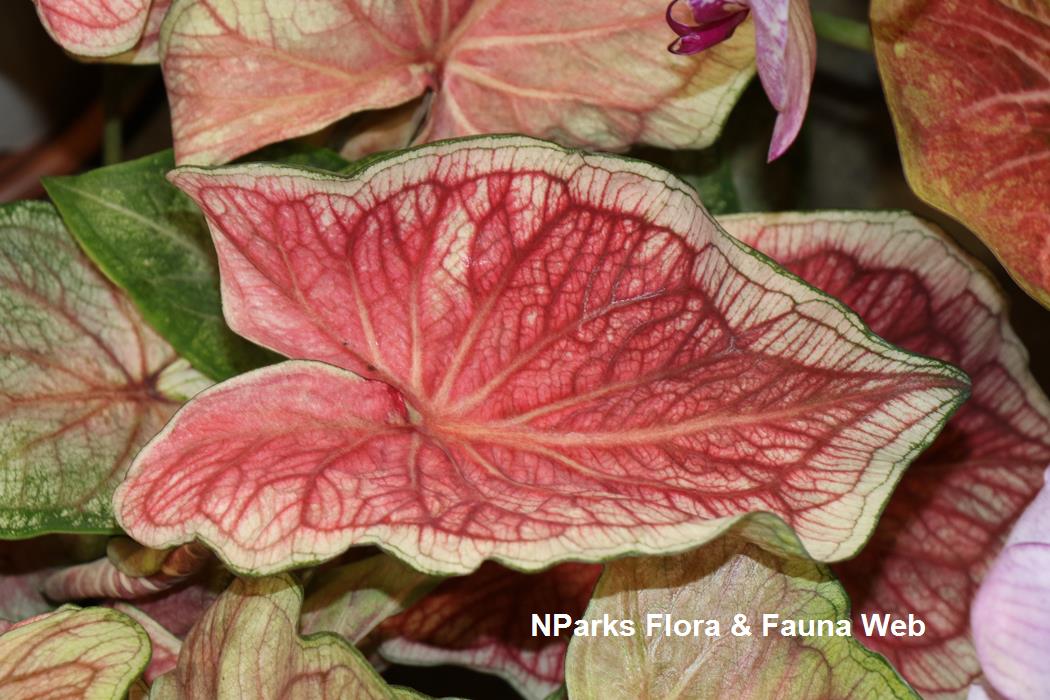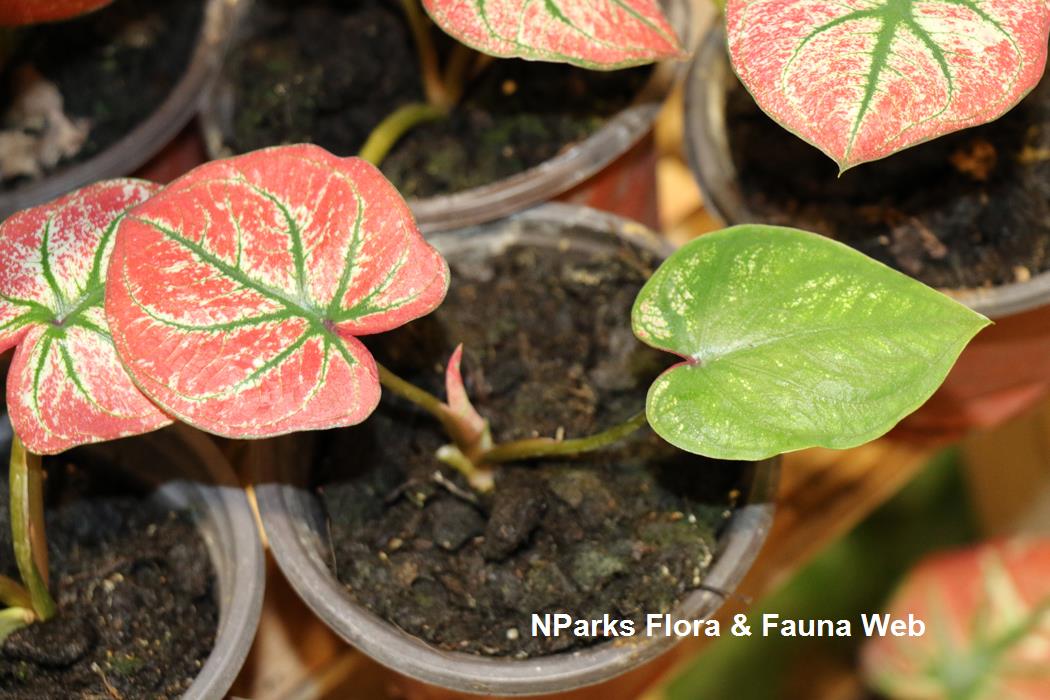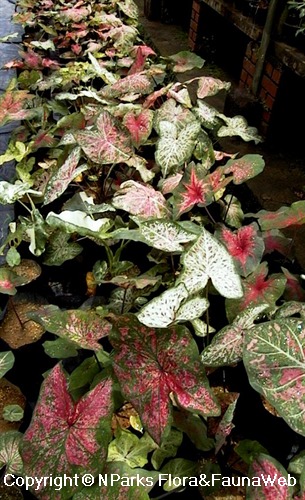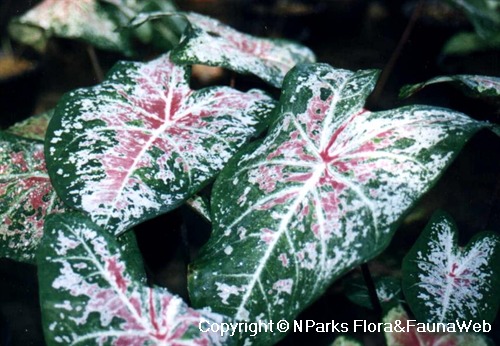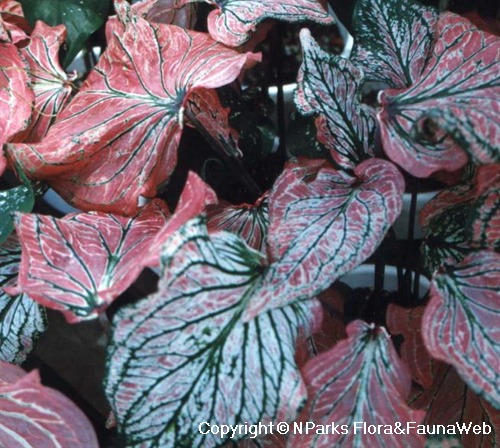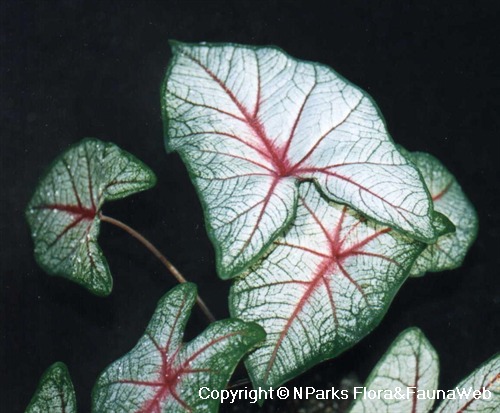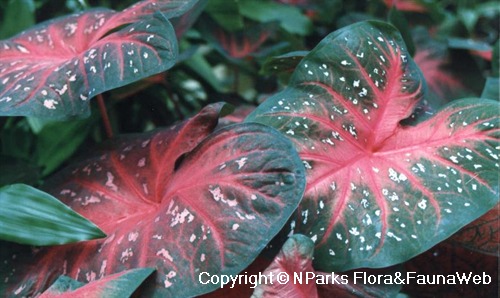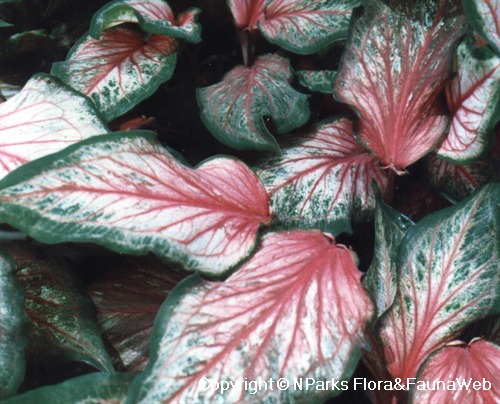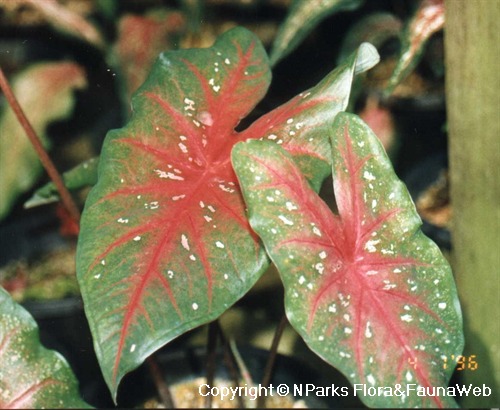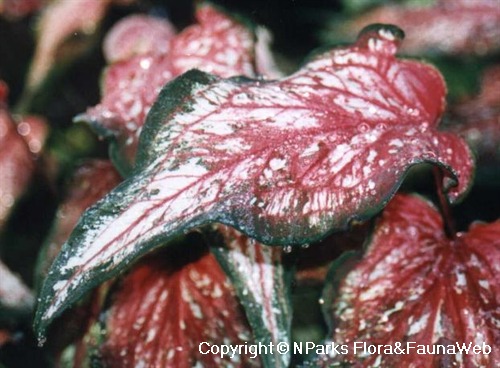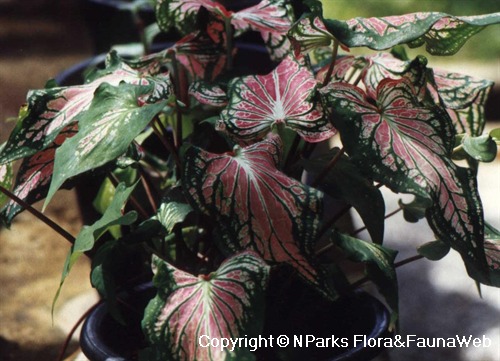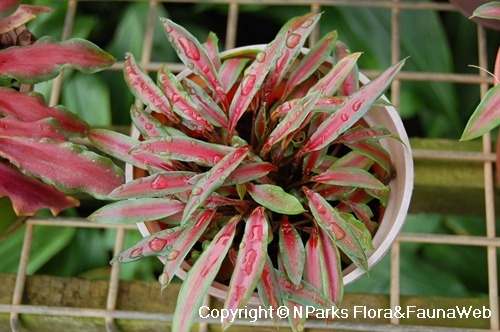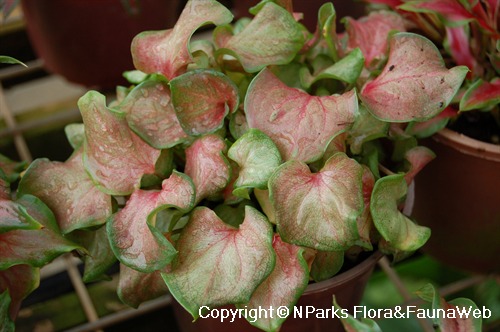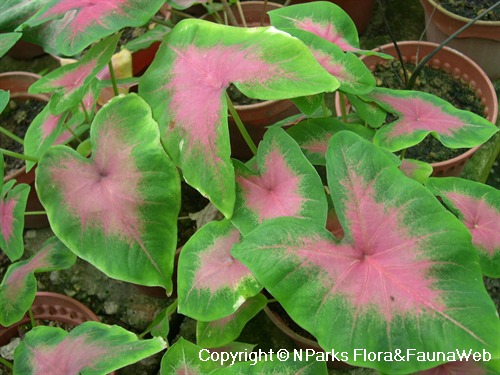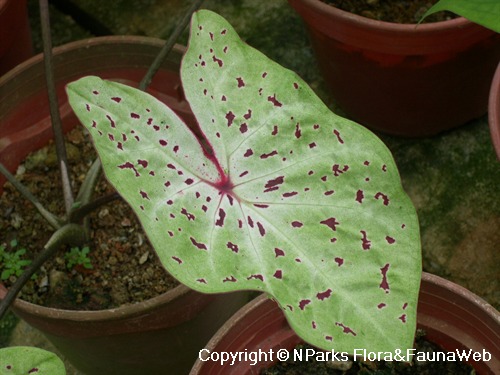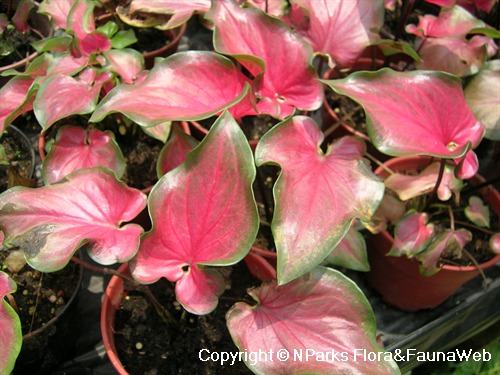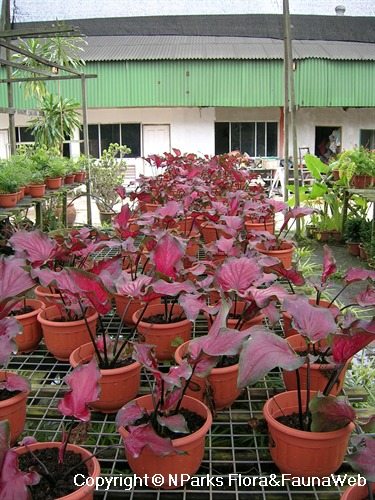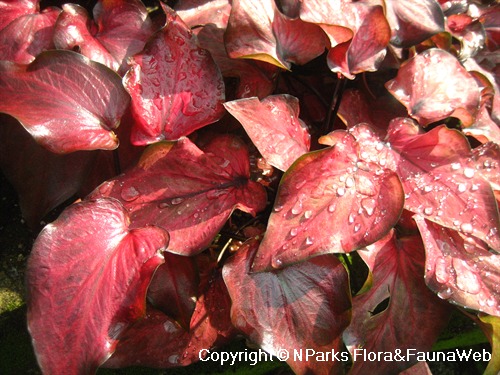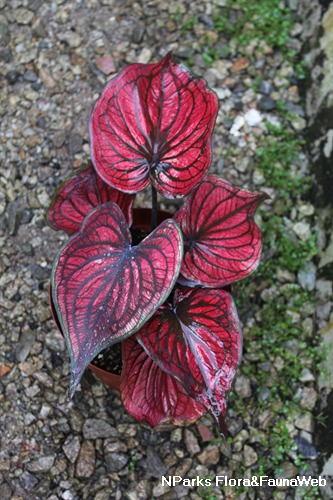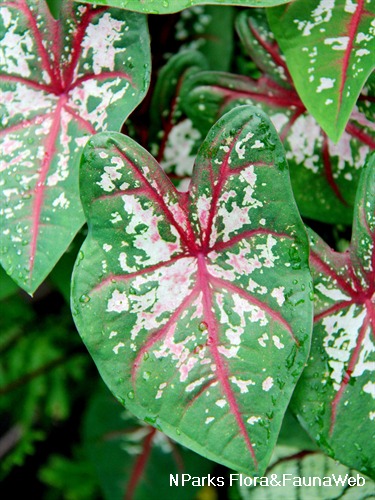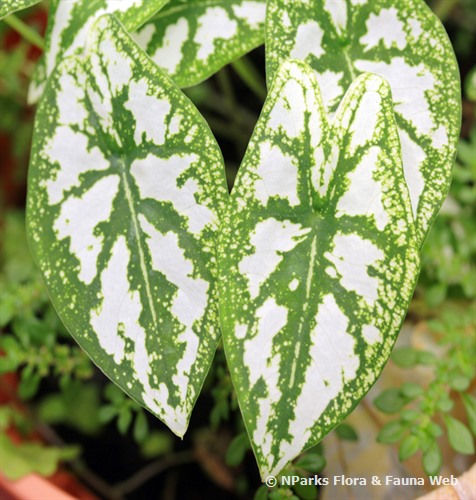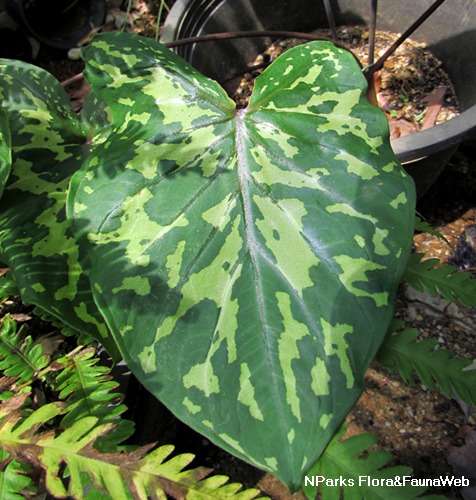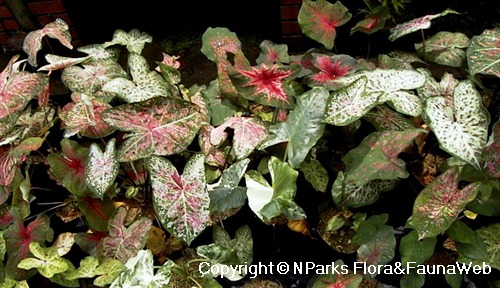
Back
Caladium bicolor cultivars
| Family Name: | Araceae |
| Synonyms: | Caladium × hortulanum |
| Common Name: | Fancy Leaf Caladium, Caladium, Angel Wings, Heart of Jesus, Elephant's Ears |
Caladium bicolor is a perennial herbaceous plant that has been widely cultivated and bred for its ornamental leaves of a variety of patterns and colours. The heart-shaped or arrowhead-shaped leaves are produced from swollen, underground stems (corms). Plants may remain dormant in the soil when suitable conditions are not met.
Name
Classifications and Characteristics
| Plant Division | Angiosperms (Flowering Seed Plants) (Monocotyledon) |
|---|---|
| Plant Growth Form | Herbaceous Plant |
| Lifespan (in Singapore) | Perennial |
| Mode of Nutrition | Autotrophic |
| Plant Shape | Compact |
| Maximum Height | 0.3 m to 0.9 m |
Biogeography
| Native Distribution | Species is from tropical South America & the Caribbean |
|---|---|
| Preferred Climate Zone | Tropical, Sub-Tropical / Monsoonal |
| Local Conservation Status | Non-native (Horticultural / Cultivated Only) |
Description and Ethnobotany
| Growth Form | It is a perennial, herbaceous plant, forming clumps up to 0.9 m tall but often shorter, with underground corms. |
|---|---|
| Foliage | The leaves are thin, usually with heart-shaped or arrowhead-shaped leaf blades, but may be oblong or crinkled in some cultivars. The colouration of the leaves are generally a combination of a green base with varying zones, spots or splashes, often in reds and pinks. The leaves are deciduous, often absent in unsuitable conditions. |
| Stems | The stem is an underground corm (thick, often round, modified stem). Offshoot corms from the mother corm will form a clump. |
| Flowers | The inflorescence is a spadix borne on a long peduncle (central stalk on inflorescence) and subtended by a light-green spathe. The spadix can reach up to 6- 10 cm tall, with a finger-like appendix (upper, infertile portion of the spadix), followed by reduced male flowers and reduced female flowers towards the base. Flowers are produced infrequently under local conditions. |
| Fruit | The infructescence is a cylindrical cluster of white berries. |
| Cultivation | It grows best in acidic soils rich in organic matter. Fertilise regularly with a low-nitrogen or balanced fertiliser. |
| Etymology | Genus Caladium is derived from Malay keladi (Taro-yam), referring to the similar appearance to Colocasia, a closely-allied genus. |
Landscaping Features
| Desirable Plant Features | Ornamental Foliage |
|---|---|
| Landscape Uses | Container Planting, Focal Plant, Flowerbed / Border |
| Usage Hazard - Cons | Irritant - Sap, Toxic Upon Ingestion |
| Usage Hazard - Cons Remarks | Irritant Sap/ Toxic Upon Ingestion: All plant parts contain calcium oxalate raphides, which are needle-shaped crystals that can cause irritation to skin, mouth and throat. Keep plants away from children and pets. |
Plant Care and Propagation
| Light Preference | Full Sun, Semi-Shade |
|---|---|
| Water Preference | Lots of Water |
| Plant Growth Rate | Moderate |
| Rootzone Tolerance | Fertile Loamy Soils, Well-Drained Soils |
| Pest(s) | Sucking Insects |
| Propagation Method | Storage Organ (Corm), Division |
Foliar
| Foliage Retention | Deciduous |
|---|---|
| Mature Foliage Colour(s) | Green, Red, Orange, Pink, Patterned, White, Yellow / Golden |
| Mature Foliage Texture(s) | Thin, Smooth |
| Foliar Type | Simple / Unifoliate |
| Foliar Arrangement Along Stem | Rosulate / Rosette |
| Foliar Attachment to Stem | Petiolate |
| Foliar Shape(s) | Non-Palm Foliage (Cordate, Sagittate) |
| Foliar Margin | Entire |
| Foliar Apex - Tip | Rounded |
| Foliar Base | Cordate, Sagittate |
| Typical Foliar Area | Mesophyll ( 45cm2 - 182.25 cm2 ) |
| Leaf Area Index (LAI) for Green Plot Ratio | 3.5 (Shrub & Groundcover - Monocot) |
| Foliage Retention Remarks | Occasionally deciduous, when conditions are not met |
Non - Foliar and Storage
| Stem Type & Modification | Herbaceous |
|---|---|
| Root Type | Underground (Fibrous Root) |
| Specialised Storage Organ(s) | Underground (Corm) |
Floral (Angiosperm)
| Flower & Plant Sexuality | Bisexual Flowers |
| Flower Colour(s) | White |
|---|---|
| Flower Grouping | Cluster / Inflorescence |
| Flower Size - Remarks | Small, inconspicuous, hidden within spathe |
| Inflorescence Type | Spathe & Spadix |
Image Repository
Others
| Master ID | 447 |
|---|---|
| Species ID | 1743 |
| Flora Disclaimer | The information in this website has been compiled from reliable sources, such as reference works on medicinal plants. It is not a substitute for medical advice or treatment and NParks does not purport to provide any medical advice. Readers should always consult his/her physician before using or consuming a plant for medicinal purposes. |

